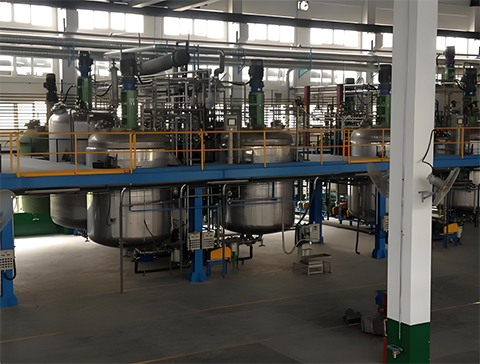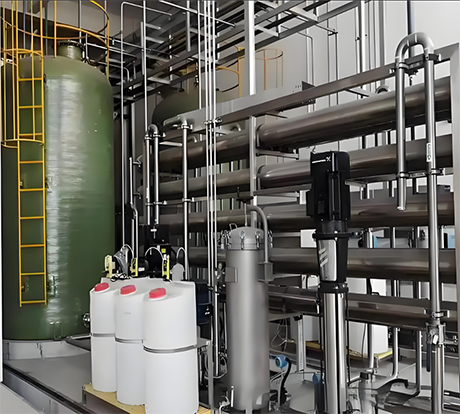Trimethylsilyl trifluoromethanesulfonate (TMSOTf) is a highly effective and widely used reagent in organic synthesis across various chemical industries, including pharmaceuticals and materials science. While its utility is undeniable, the process of manufacturing TMSOTf involves several steps and materials that carry potential environmental risks. This analysis delves into the possible pollution issues associated with TMSOTf production and discusses mitigation strategies.

The general process for producing TMSOTf typically involves the reaction of trifluoromethanesulfonic acid (triflic acid) with a silicon source, such as trimethylsilyl chloride (TMSCl) or hexamethyldisilazane (HMDS). This synthesis, while crucial for obtaining the desired product, presents several environmental considerations:
Based on the typical synthesis routes, the production of TMSOTf can generate various pollutants:
Acidic Gases: The reaction, particularly when using trimethylsilyl chloride, often produces hydrogen chloride (HCl) gas. HCl is corrosive and, if not properly managed, contributes significantly to air pollution and can lead to acid rain.
Volatile Organic Compounds (VOCs): Organic solvents are frequently used during the synthesis, purification, and cleaning steps. Evaporation of these solvents releases VOCs into the atmosphere, contributing to air quality degradation and smog formation.
Hazardous Liquid Waste: Spent reaction mixtures, unreacted starting materials, used solvents, and wash water form liquid waste streams. These often contain corrosive, toxic, or flammable chemicals requiring careful treatment and disposal.
Solid Waste: This includes residues from filtration, spent catalysts, and other process byproducts. If contaminated with hazardous substances, proper handling and disposal are essential to prevent soil and groundwater contamination.
Fluorine-containing Byproducts: Given that trifluoromethanesulfonic acid is a key reactant, there is a potential for generating various fluorine-containing organic or inorganic byproducts that may be persistent or toxic.

Without stringent pollution control measures and responsible waste management, the release of these substances can lead to significant environmental harm:
Air Quality Degradation: Emissions of acidic gases (like HCl) and VOCs directly impact air quality, contributing to respiratory problems, damaging vegetation, and forming harmful ground-level ozone.
Water Contamination: Improperly treated or discharged wastewater can pollute surface water (rivers, lakes) and groundwater. This harms aquatic ecosystems, affects biodiversity, and can contaminate sources of drinking water.
Soil Pollution: Spills, leaks, or inadequate disposal of solid and liquid waste can contaminate soil. This impacts soil fertility, harms plant life, and can allow hazardous substances to leach into groundwater or enter the food chain.
Ecotoxicity: Many of the chemicals involved in TMSOTf production, including the raw materials, intermediates, and byproducts, can be toxic to various organisms in the environment, disrupting ecosystems.
Minimizing the environmental impact of TMSOTf production requires a comprehensive and proactive approach focused on pollution prevention and control:
Advanced Emission Control: Implementing high-efficiency scrubbers, adsorbers, or thermal oxidizers to capture and neutralize acidic gases and VOCs from process exhaust streams before they are released into the atmosphere.
Effective Wastewater Treatment: Employing robust multi-stage wastewater treatment processes (including physical, chemical, and potentially biological methods) to remove contaminants from liquid waste streams, ensuring compliance with strict discharge standards.
Responsible Waste Management: Implementing strict procedures for the segregation, handling, storage, and safe disposal of all solid and hazardous waste. Prioritizing waste reduction at the source, reuse, and recycling opportunities where feasible.
Process Optimization and Green Chemistry: Continuously researching and implementing more efficient synthetic routes that minimize the use of hazardous raw materials, reduce the number of reaction steps, and decrease the volume and toxicity of generated waste. This aligns with the principles of green chemistry.
Strict Regulatory Compliance: Adhering to all national, regional, and local environmental laws, regulations, and permitting requirements. This often involves regular monitoring and reporting of emissions and discharges.
Environmental Risk Assessment and Management: Conducting thorough risk assessments to identify potential environmental hazards and developing emergency response plans to prevent accidents (like spills or leaks) and mitigate their impact if they occur.
Closed-Loop Systems: Where possible, implementing closed-loop systems for solvent recovery and recycling to reduce consumption and minimize emissions.
While the production of Trimethylsilyl trifluoromethanesulfonate presents inherent environmental challenges due to the nature of the chemicals involved, it is not necessarily a process of "heavy pollution" if managed responsibly and ethically. The potential for significant environmental impact exists, particularly in the absence of effective environmental controls. However, by implementing comprehensive pollution control technologies, optimizing processes based on green chemistry principles, investing in robust waste management systems, and maintaining strict adherence to environmental regulations, manufacturers can significantly mitigate the environmental footprint of TMSOTf production.
The chemical industry has a responsibility to prioritize sustainable development. By embracing innovation in greener synthesis methods and investing in state-of-the-art environmental protection measures, the production of essential chemicals like TMSOTf can be carried out in a manner that minimizes harm to the environment and protects public health. The focus should be on continuous improvement towards more sustainable and environmentally friendly chemical synthesis practices.
Contact: Tony Li
Phone: +86-13263299644
Tel: +86-13263299644
Email: sales@ecoviaet.com
Add: No 3 Youyi Road,Tangshan,Huantai,Zibo,China
We chat
